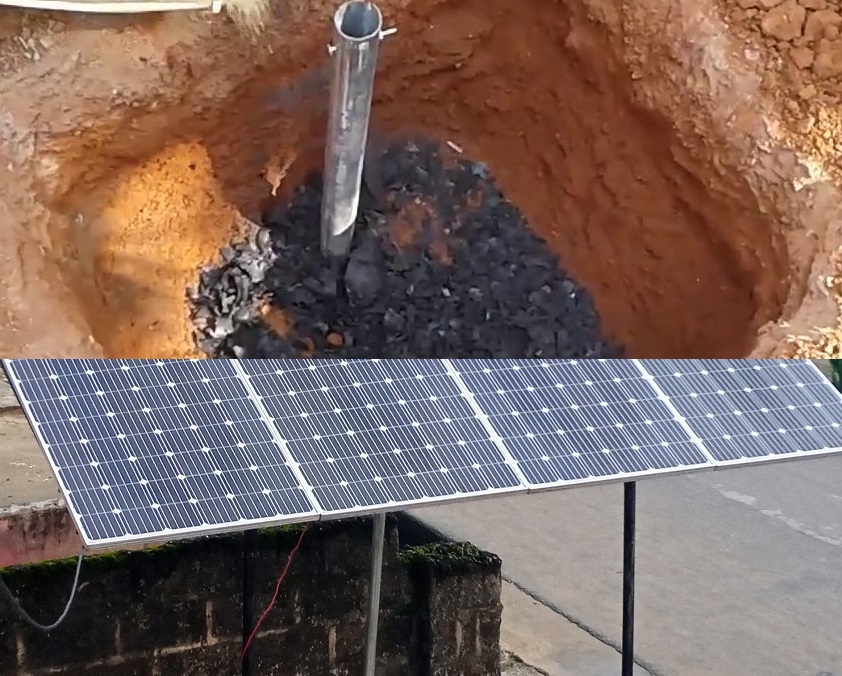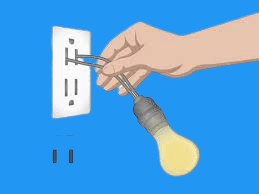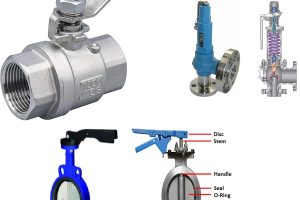After you have installed your solar components and everything starts working normally, you need to protect your solar systems so that no thunder or lightning can cause damage to any of the solar components, especially the inverter. An effective earthing system must provide a very low resistance path to the earth through which excess charges can easily flow through during over-voltage or fault current flow, usually caused by lightning or thunderstorm. In this article, you will learn the various effective ways to ground your solar system and the electrical connections of your building, depending on your installation style or pattern.

How Does Lightning Affect a Solar System & Components?
It has been proven that of all solar components, the inverter is most prone to lightning effect. For instance, if you installed your solar panels in roof tops where there is no thunder arrestor or effective earthing. When lightning strikes on the roof, especially in tall buildings, some of the excess charges or high voltages produced by the lightning are likely to pass through the PV modules and then flow through the solar cables to your charge controller. Most times, these excess currents and voltages flow through the charge controller and battery banks without causing any damage. But when these excess charges reach the inverter, it damages some delicate components of the inverter system. This might lead to partial or complete damage of your inverter system. Although special types of inverters (like the hybrid inverters) are built to survive such lightning effects, other lower inverter grades don’t.
Different Ways to Protect Solar PV System from Lightning Effect
To avoid such costly damage, you need to effectively earth your solar system. There are many ways to protect your solar system, depending on where the solar panels were installed and the earthing condition of your building.
If thunder arrestors are properly installed in the roof of the building and the house is effectively earthed, even if the solar panels are installed on such protected roofs, then you don’t need to spend money protecting your solar system. All you do is to make sure that the earthing core from the inverter input (usually connected to the mains) is linked to the existing earthing system of the building. Once that is done, your solar system is protected from the effect of lightning and thunderstorm.
In the case where the solar panels are installed on the roof tops, where there is no thunder arrestor in the roof, but the building is properly or effectively earthed, all you need to do is to install a lightning arrestor in the roof of the building and then link it to the existing earthing system of the building via a copper cable (of at least 4mm diameter). Also make sure that the inverter is properly earthed via the mains (as explained above).
Another case is where the solar panels are installed on standalone solar grids or tower. If the building where the solar system is connected is effectively earthed, simply installed a lightning arrestor on the highest height of the standalone structure or tower where the panels were fixed and connect it to the existing earthing system of the building.
The worst case scenario is if there is no effective earthing system in the building at all. Here, you need to do an effective earthing for the building and then link the solar panels and inverter input earthing core to this new earthing system. You can contact a professional electrical electrician for this work. Another option is to make use of DC and AC surge protectors. You can connect the DC surge protector in between the charge controller and the battery bank or in between the battery bank and the inverter. For the AC surge protector, connect it in between the inverter input wire and the wire coming from your mains. For each surge protector connection, you will need a circuit breaker (CB) that will take care of the switching action during over-voltage or fault current flow in the system.
Components/Tools Needed for Effective Earthing
Here are some of the basic things you will need for the earthing:
- Earthing rod (pure copper) of at least 4 ft. length
- Industrial salt
- Charcoal
- Earthing link
- Surge arrestor or spike
- Pure copper cable of at least 4mm diameter
Other tools required for earthing include:
- Plier
- A continuity tester
- Digger, shovel, or any excavation tool
- Hammer (for driving the earth rod further into the ground, optional)
Steps by Step Guide for Earthing a Building/Solar System
- First, dig a pit where the earthing rod will be buried with your excavation tool. The pit should about 3 meter deep and at least 1.5 meter wide. Try to choose an area close to the house, the solar arrays or any structure you wish to earth.
- Now pour about half portion of the salt and charcoal and cover them a little with sand. Then place earth rod vertically in the middle of the pit. You might need to use a hammer to drive the earth rod further into the ground until the upper part of the earth rod is on normal ground level or a little bit below ground level.
- Now pour the remaining portion of salt and charcoal in the pit.
- Use the earth wire to connect the earthing link and the earthing rod or electrode.
- Use a plier to adjust the clamp.
- You can pour some buckets of water in the hole.
- Then cover the pit with sand.
- Now use a continuity tester to test for continuity.
NOTE:
Depending on the soil conditions, a longer or multiple earthing rod will help to help to achieve the best possible lowest resistance path during over-voltage or fault current flow.
After earthing, the total resistance of the earthing system should not exceed 1 ohm. If it exceeds 1 ohm, then the earthing system is not effective. You can add extra earthing rod(s) and drive them further into the ground with a hammer. This will help to reduce the resistance of the earthing system.
Always make sure that your earthing system has only one grounding point. Avoid looping multiple grounding points. These multiple grounding points will create multiple paths for current flow, which may make your charge controller to function incorrectly and also reduce the efficiency of your entire earthing system.
Make sure you ground all exposed non-current-carrying metallic objects like the body of your charge controller, frames of your solar panels, mounting frame, etc.
Look for an experienced electrician to help you do the grounding to avoid malfunctions that usually arise from ineffective or faulty earthing.
Do you wish to learn the step by step guide for solar PV system design and installation? Then check out this eBook on Amazon: Complete Solar PV System Installation Guide. It contains DIY guides for installing grid and off-grid solar PV systems, how to build solar-powered electric cars and the various ways to make money from the solar energy sector.
See:
- How to Convert Conventional Cars to Solar-Powered Electric Cars
- Various Ways to Make Solar System Wiring/Connections for Home
How to Check if a Building is Grounded or Not
You can use a test bulb (usually has 2 wires) or a multimeter to check if a house is earthed or not. Even if it is earthed, you still need to check if the earthing system is still functional or not. The test bulb can only be used on alternating current (AC). While the multimeter can be used on both AC and direct current (DC), and is more accurate.
To check if a building or structure is earthed using a test bulb:
- Make sure there is electric power in the building. You can power the house with a generator.
- Plug one wire from the test bulb to the positive port of a socket (usually the right port). Then plug the other wire from the test bulb on the negative port (usually the left port).

A test bulb for checking the earthing of a building - Now ON the socket switch. The bulb should glow brightly.
- Off the socket switch. Transfer the wire on the negative port to the earthing port (usually the above port) of the socket.
- Again, ON the socket switch. The bulb should glow brightly as before if the earthing is still functional and active. If there is no earthing system, the bulb will not glow at all. But if the bulb glows and dims, then it indicates that the earthing system is faulty or not active.
To check if a building or structure is earthed using a multimeter:
- If you are checking for AC current, move the pointer of the multimeter to “AC”. If you are checking for DC current, you move the pointer of the multimeter to “DC”.
- Insert the red probe to the port labelled “V”, “Ω” or “+” (as the case may be. Any of these ports can serve). Then insert the black probe to the port labelled “COM” or “-“.
- Now put the other end of the red probe in the positive port of the socket. Also put the other end of the black probe to the negative port of the socket.
- Turn ON the socket switch. Check the reading on the multimeter and take note of it.
- Now turn OFF the socket switch. Transfer the black probe from the negative port of the socket to the earthing port. Then turn the socket switch ON.
- Check the new reading on the multimeter. It should be the same with the previous reading. If there is no reading or the reading is lesser in value than the previous one, it implies either that the earthing system is faulty or the building was not earthed.
Conclusion
Grounding your solar system provides safety for your components and makes sure no sudden lightning strike will cause a damage in your home. You have learnt the various ways to earth your solar system, depending on your solar system size and installation pattern. Also, you learnt the necessary equipment needed for effective grounding. Apply these tips when grounding and protect your solar system.
Did you find any section of this tutorial article confusing? Drop your question in the comment section below. Share this article with your social media friends by clicking a share button. Subscribe to our blog via email to stay up to date with our upcoming tutorial articles. Enjoy!
Follow us on social media






